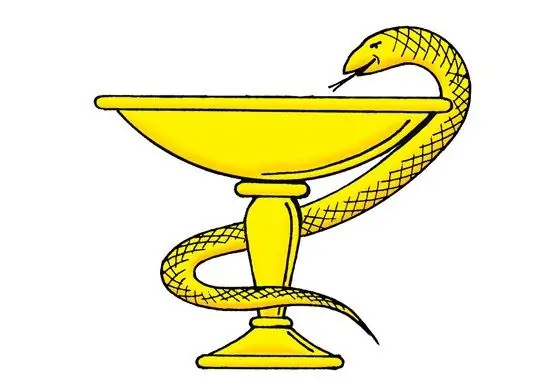The sign - a snake, entwined with a charm, is called the "Hippocratic Chalice". It is currently one of the main symbols of Russian healthcare. For all peoples, the snake personifies youth, wisdom, infinity of life.

Ancient signs of medicine
There are many medical emblems. A cup entwined with a snake is a Russian medical symbol. In general, the image of a snake in medicine has been intensively exploited by the peoples of the world. For example, in Egypt it was the professional distinction of doctors. The Egyptian goddess of healing Isis is entwined by a snake, personifying health. The legends and tales of Ancient Babylon and Africa tell about the healing properties of reptiles.
The origin of the cup as a symbol of medicine is explained by the tradition of preparing medicine in a ritual vessel, or by the fact that in the arid desert regions of the East, precious moisture, pouring from heaven and bringing life, was collected in the vessel.
Who united the bowl and the snake into a single whole is unknown. Found images of a snake and a bowl date back to 600 BC. NS. On them, the Greek goddess of health Hygea, the daughter of Aesculapius, feeds a snake (snake) from a spell, she holds it in one hand, and a snake in the other.
It was the snakes that were considered the owners of magical healing powers and lived in the healing center of the god of healing Aesculapius. In the ancient world, they embodied a good beginning, guaranteed the well-being of the home and the health of the people living in it.
Symbol of Russian military medicine
Subsequently, this emblem was forgotten and only in the 16th century, according to Academician E. N. Pavlovsky, a snake appeared, coiled around the bowl, thanks to the famous healer Paracelsus at that time.
The meaning of this sign and the contents of the cup are still controversial. It is logical to assume that the bowl contains snake venom, which is known to have healing properties. Therefore, this emblem is considered the most acceptable for pharmacology.
The snake is a symbol of wisdom and immortality. It is believed that this is a reminder to the doctor that one must be reasonable, and draw wisdom from the cup of knowledge of nature. One of the first to think about the contents of the cup was the historian and physician F, R. Borodulin. He suggested that the charm is a symbol of the mind, which embraces the knowledge of the world.
In Russia, a cup entwined with a snake appeared under Peter I as a distinction of military medicine. This symbol was also inscribed on the coat of arms, granted along with the nobility to the Assessor of Pharmacy to the Lublin Apothecary Karl Friedrich, son of Ginch by Emperor Nicholas I for loyalty to the throne.
The young Soviet government took over the baton from the tsarist government and the symbol of military medicine - a snake that coiled a cup and bowed its head over it - was approved in 1924 by the Revolutionary Military Council. This sign is still the common emblem of the Russian military medical service.







